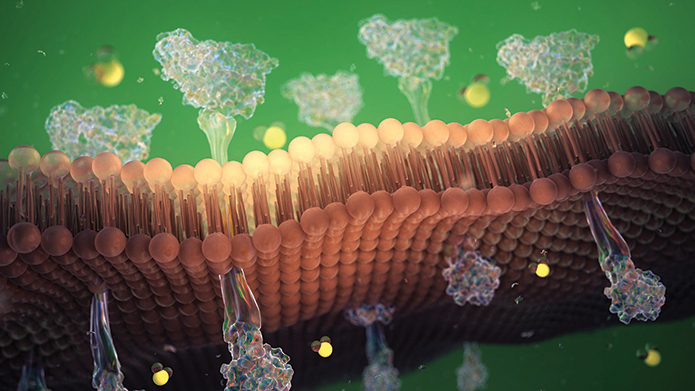Phospholipids and innate immunity
The innate immune system is an ancient evolutionary arm of defense that responds to acute trauma by generating a barrier that prevents pathogen invasion and arrests bleeding. It also patrols healthy epithelial tissues, monitoring and responding to foreign antigens and supporting development of adaptive immunity.
 This representation of a phospholipid bilayer shows integral membrane proteins protruding throughout.
This representation of a phospholipid bilayer shows integral membrane proteins protruding throughout.
Healthy functioning of the innate immune system relies on communication among diverse cell types, both from the bloodstream and based in stromal tissues such as epithelia and fibroblasts. Here, phospholipid signaling takes center stage in diverse ways, many of which we are only beginning to understand.
Phospholipids, or PLs, provide the membranes that hold our cells together. Researchers increasingly appreciate how these unique and diverse lipids also play essential roles in communicating within the immune system and how this is required for human health and disease. Indeed, PLs and their metabolic products are central players in vascular inflammation, hemostasis, immunity, cancer, infection and cardiovascular disease.
Here is some of what we know about PL biology in mammals so far:
Prostaglandin and eicosanoid precursors: Researchers long have known that PL hydrolysis provides polyunsaturated fatty acid substrates for generation of eicosanoids and prostaglandins by cyclooxygenases and lipoxygenases. This involves large families of phospholipases expressed in a cell-specific manner. Prostaglandins signal by activating well-characterized G protein-coupled receptors, or GPCRs, after they are secreted from immune and stromal cells during inflammation.
Phosphoinositides: The phosphorylation of inositol headgroups of phosphatidylinositol at up to three sites leads to a multitude of PL products that are potently bioactive and highly transient. These lipids form short-lived membrane anchors for kinases that regulate GPCRs, apoptosis and endocytosis.
Platelet activating factor: This extremely transient lipid contains a choline headgroup, and an alkyl bond at sn1. According to , it is a plasmanylcholine, with an acetyl group at sn2. The chain at sn1 is generally a 16:0 ether, but variants of other length also show bioactivity towards platelets.
Phospholipase C and phospholipase D: Families of enzymes called PLCs cleave PLs to form diacylglycerol and release the phosphorylated headgroup. Diacylglycerols are potent activators of the protein kinase C pathway, while the PL headgroup mobilizes calcium. PLD metabolizes phosphatidylcholine to form phosphatidic acid, an intracellular molecule that regulates proteins involved in Ras and Rac1 signaling.
Enzymatically oxidized PL: Researchers long have known that PLs oxidize in atherosclerosis and inflammation via nonenzymatic processes. Now, they are finding that a cell-specific group of related lipids, generated by enzymatic oxidation, is formed in innate immune cells in the bloodstream. These lipids allow the interaction of coagulation factors with cell membranes, an event required for blood clotting. A deficiency of enzymatically oxidized PLs, or eoxPLs, leads to too much bleeding, and studies suggest eoxPLs are involved in vascular inflammatory diseases such as aneurysms. In some situations, eoxPLs and their nonenzymatically generated analogs may be regulators of ferroptosis, an iron-dependent cell-death process relevant for cancer and organ failure.
Phospholipid innate immune recognition: Both self- and pathogen-derived PLs can act as ligands for a family of MHC class I-like antigen-presenting molecules called CD1. Lipid reactive T cells such as natural killer T cells then recognize the lipid-CD1 complexes. This type of antigen recognition shows significant molecular diversity in terms of PL species implicated, and a role is emerging for CD1-lipid presentation in human allergies, including to dust mites, pollen and bee sting.
recently published a review covering these aspects of PL signaling in the innate immune system in the Journal of Clinical Investigation.
(Terminology in the section of this article on platelet activating factor was corrected by the author on Nov. 14, 2019.)
Enjoy reading ASBMB Today?
Become a member to receive the print edition four times a year and the digital edition weekly.
Learn moreGet the latest from ASBMB Today
Enter your email address, and we’ll send you a weekly email with recent articles, interviews and more.
Latest in Science
Science highlights or most popular articles

Transforming learning through innovation and collaboration
Neena Grover will receive the William C. Rose Award for Exemplary Contributions to Education at the 2025 ASBMB Annual Meeting, April 12–15 in Chicago.

Guiding grocery carts to shape healthy habits
Robert “Nate” Helsley will receive the Walter A. Shaw Young Investigator in Lipid Research Award at the 2025 ASBMB Annual Meeting, April 12–15 in Chicago.

Quantifying how proteins in microbe and host interact
‚ÄúTo develop better vaccines, we need new methods and a better understanding of the antibody responses that develop in immune individuals,‚Äù author Johan Malmström said.

Leading the charge for gender equity
Nicole Woitowich will receive the ASBMB Emerging Leadership Award at the 2025 ASBMB Annual meeting, April 12–15 in Chicago.

CRISPR gene editing: Moving closer to home
With the first medical therapy approved, there’s a lot going on in the genome editing field, including the discovery of CRISPR-like DNA-snippers called Fanzors in an odd menagerie of eukaryotic critters.

Finding a missing piece for neurodegenerative disease research
Ursula Jakob and a team at the University of Michigan have found that the molecule polyphosphate could be what scientists call the “mystery density” inside fibrils associated with Alzheimer’s, Parkinson’s and related conditions.

